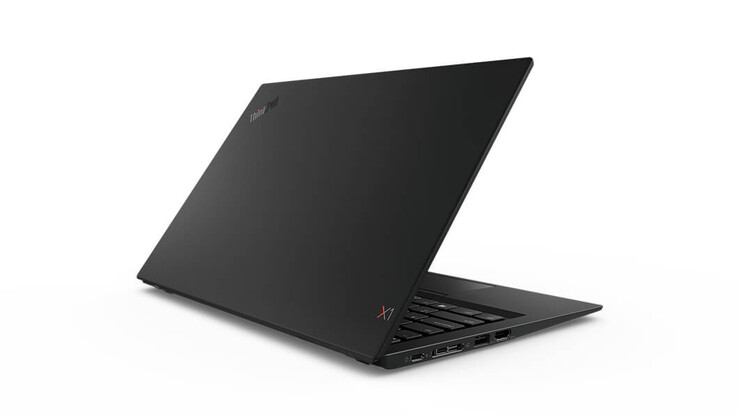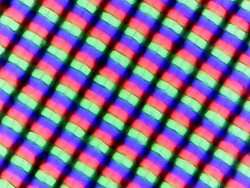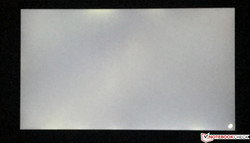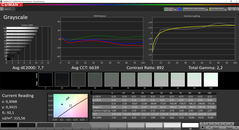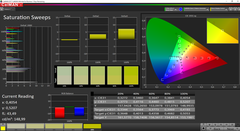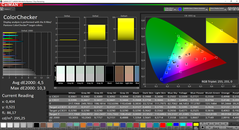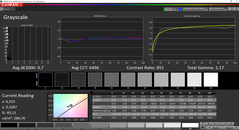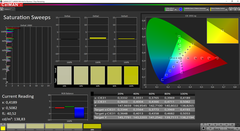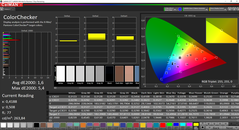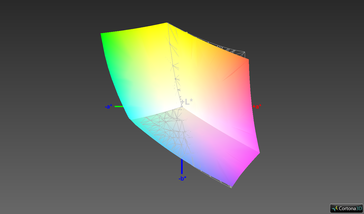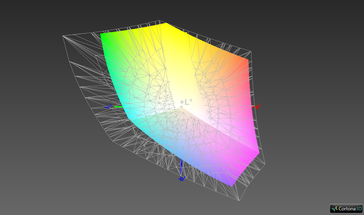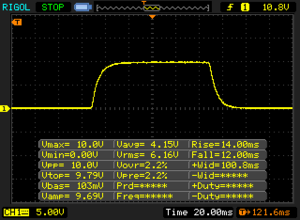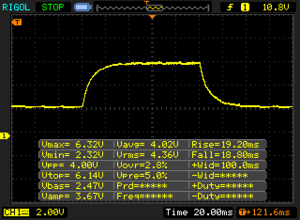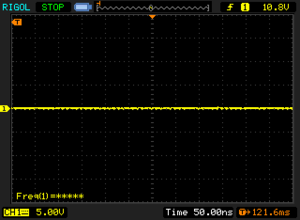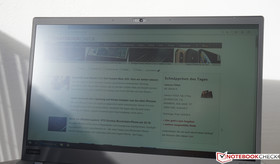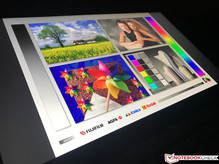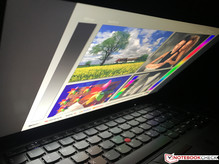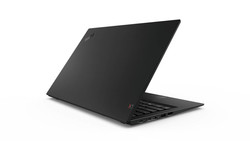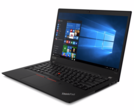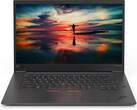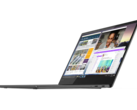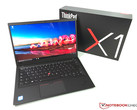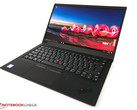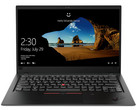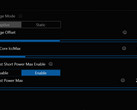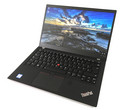Lenovo ThinkPad X1 Carbon 2018 (matte WQHD, i7) Laptop Review

At this year's CES, Lenovo already announced the 2019 model of the ThinkPad X1 Carbon. However, the devices will only become available by the middle of the year. We have already evaluated the sixth generation of the X1 Carbon with the WQHD HDR panel, the regular FHD display, and the Full HD touchscreen, and now we are also taking a look at the matte WQHD panel.
Our test unit is a Campus model (20KGS5DU00) with the Core i7-8550U, a 512 GB SSD, 16 GB of RAM, and an LTE module that costs 1899 Euros (~$2159). There is no corresponding (preconfigured) top model for regular customers, but you can configure a similar device in Lenovo's online shop. The price is ~2340 Euros (~$2660; a model with the i7-8650U but otherwise similarly equipped costs $1702 in the US).
We already looked at the device including the connections and input devices in detail and also tested the performance of the X1 Carbon with the Core i7, so in this article we will concentrate on the new display and its effects on the battery life. All the remaining information is available in the following two reviews, and a look into the review of the 2017 version with the matte WQHD panel might also be worthwhile:
Display
Potential buyers of the current ThinkPad X1 Carbon have a choice between four different displays: 2x Full HD (1x touch, both matte), matte WQHD, and glossy WQHD HDR. In terms of brightness and color-space coverage, the optional WQHD-HDR model is definitely the best choice, but it also has a very reflective surface. Anyone who mainly wants to carry out work-related tasks on the laptop and also occasionally wants to take it on the road will probably prefer a matte display.
The characteristics of the two 1080p screens are very similar, offering a decent brightness of about 300 cd/m², while there are naturally also some variations within the series. We already know the matte WQHD panel from the 2017 X1 Carbon, since it again comes from LG Philips (LP140QH2-SPB1). The average brightness is 311 cd/m² and thus slightly behind the device from 2017. Both share the elevated black value, causing the contrast ratio to reach only slightly above 900:1. However, subjectively the image is still very good, particularly for a business device. The image is also not grainy, which can be the case with some matte displays from time to time. You can see slight halos at the edges, but PWM is not used for brightness control. Another advantage compared to the glossy WQHD model is the significantly faster response times; there is no ghosting here.
| |||||||||||||||||||||||||
Brightness Distribution: 84 %
Center on Battery: 320 cd/m²
Contrast: 903:1 (Black: 0.35 cd/m²)
ΔE ColorChecker Calman: 4.5 | ∀{0.5-29.43 Ø4.78}
calibrated: 1.6
ΔE Greyscale Calman: 7.7 | ∀{0.09-98 Ø5}
97.9% sRGB (Argyll 1.6.3 3D)
68.6% AdobeRGB 1998 (Argyll 1.6.3 3D)
74.6% AdobeRGB 1998 (Argyll 3D)
97.9% sRGB (Argyll 3D)
72.7% Display P3 (Argyll 3D)
Gamma: 2.2
CCT: 6639 K
| Lenovo ThinkPad X1 Carbon 2018-20KGS5DU00 LP140QH2-SPB1, IPS, 2560x1440, 14" | Lenovo ThinkPad X1 Carbon 2018-20KGS03900 B140QAN02.0, IPS, 2560x1440, 14" | Lenovo ThinkPad X1 Carbon 2018-20KGS03800 B140HAN03.1, , 1920x1080, 14" | Lenovo ThinkPad X1 Carbon G6-20KG0025UK Lenovo LEN40A9 / AUO B140HAK02.3, IPS, 1920x1080, 14" | Lenovo ThinkPad X1 Carbon 2017-20HR006FGE LEN40AA (LP140QH2-SPB1), IPS, 2560x1440, 14" | Average of class Subnotebook | |
|---|---|---|---|---|---|---|
| Screen | 43% | 9% | 24% | 9% | 42% | |
| Brightness middle (cd/m²) | 316 | 578 83% | 330 4% | 298 -6% | 342 8% | 425 ? 34% |
| Brightness (cd/m²) | 311 | 533 71% | 311 0% | 287 -8% | 337 8% | |
| Brightness Distribution (%) | 84 | 84 0% | 87 4% | 91 8% | 87 4% | |
| Black Level * (cd/m²) | 0.35 | 0.38 -9% | 0.21 40% | 0.2 43% | 0.37 -6% | 0.1481 ? 58% |
| Contrast (:1) | 903 | 1521 68% | 1571 74% | 1490 65% | 924 2% | |
| Colorchecker dE 2000 * | 4.5 | 1.9 58% | 4.7 -4% | 2.19 51% | 3.6 20% | 2.46 ? 45% |
| Colorchecker dE 2000 max. * | 10.3 | 3.8 63% | 9.3 10% | 4.39 57% | 7.7 25% | 5.43 ? 47% |
| Colorchecker dE 2000 calibrated * | 1.6 | 0.8 50% | 2.4 -50% | 1.67 -4% | 1.607 ? -0% | |
| Greyscale dE 2000 * | 7.7 | 3 61% | 4.5 42% | 1.97 74% | 5.8 25% | 2.45 ? 68% |
| Gamma | 2.2 100% | 2.14 103% | 1.99 111% | 2.43 91% | 2.2 100% | 2.21 100% ? |
| CCT | 6639 98% | 6377 102% | 6710 97% | 6571 99% | 6693 97% | 6580 99% ? |
| Color Space (Percent of AdobeRGB 1998) (%) | 68.6 | 88.8 29% | 58.2 -15% | 62 -10% | 68.8 0% | |
| Color Space (Percent of sRGB) (%) | 97.9 | 100 2% | 89.3 -9% | 95 -3% | 98.5 1% |
* ... smaller is better
As delivered, the panel is not calibrated optimally, since in addition to the high DeltaE-2000 deviations (mainly in the grayscale) there is also a slight green tint. All the other panel choices with the X1 Carbon did slightly better in this regard. However, if you really only use the device for everyday office work and do not intend to do any image-processing, you do not necessarily need to calibrate the display.
Our calibration shows the full potential of the WQHD panel. The slight green tint has disappeared completely, and with an average deviation of barely 0.7, the grayscale reproduction is excellent. In terms of the colors, there is also a significant improvement with an average deviation of 1.6. Only the red color remains a significant outlier. Thanks to the sRGB coverage being almost complete, the color deviations do not increase even at higher saturation levels. This makes the panel quite suitable for image-processing. Only those who work in the AdobeRGB color space should either select the optional WQHD-HDR panel or use an external monitor. As always, our calibrated icm file is freely available for download.
Display Response Times
| ↔ Response Time Black to White | ||
|---|---|---|
| 26 ms ... rise ↗ and fall ↘ combined | ↗ 14 ms rise | |
| ↘ 12 ms fall | ||
| The screen shows relatively slow response rates in our tests and may be too slow for gamers. In comparison, all tested devices range from 0.1 (minimum) to 240 (maximum) ms. » 61 % of all devices are better. This means that the measured response time is worse than the average of all tested devices (20.2 ms). | ||
| ↔ Response Time 50% Grey to 80% Grey | ||
| 38 ms ... rise ↗ and fall ↘ combined | ↗ 19.2 ms rise | |
| ↘ 18.8 ms fall | ||
| The screen shows slow response rates in our tests and will be unsatisfactory for gamers. In comparison, all tested devices range from 0.165 (minimum) to 636 (maximum) ms. » 54 % of all devices are better. This means that the measured response time is worse than the average of all tested devices (31.6 ms). | ||
Screen Flickering / PWM (Pulse-Width Modulation)
| Screen flickering / PWM not detected | |||
In comparison: 53 % of all tested devices do not use PWM to dim the display. If PWM was detected, an average of 8111 (minimum: 5 - maximum: 343500) Hz was measured. | |||
Battery Life
We were a little surprised about the battery life, since it turns out slightly more than one hour shorter compared to last year's model. In our WLAN test with the brightness adjusted to 150 cd/m² (74% in our test unit), we measure a runtime of 8:57 hours, which is about 20 minutes more than with the glossy WQHD display. Thanks to their lower resolution, the two Full HD displays use less power, lasting about an hour longer.
| Lenovo ThinkPad X1 Carbon 2018-20KGS5DU00 57 Wh, 2560x1440 | Lenovo ThinkPad X1 Carbon 2018-20KGS03900 57 Wh, 2560x1440 | Lenovo ThinkPad X1 Carbon 2018-20KGS03800 Wh, 1920x1080 | Lenovo ThinkPad X1 Carbon G6-20KG0025UK 57 Wh, 1920x1080 | Lenovo ThinkPad X1 Carbon 2017-20HR006FGE 57 Wh, 2560x1440 | |
|---|---|---|---|---|---|
| Battery runtime | |||||
| WiFi v1.3 (h) | 9 | 8.7 -3% | 10 11% | 10.4 16% | 10.1 12% |
Pros
Cons
Verdict
We have now tested all the displays that Lenovo offers for the current ThinkPad X1 Carbon. Compared to the standard 1080p IPS display, the additional costs are not too high (45 Euros/~$51 for FHD touch, 106 Euros/~$120 for matte WQHD, and 144 Euros/~$164 for WQHD HDR). Due to its glossy display, the very bright WQHD-HDR model tends to be more useful for multimedia. Those who use the ThinkPad X1 Carbon primarily for their office work and also occasionally on the road are surely better served by a matte display.
For work, the standard 1080p panel is not a bad choice. Whether you need a touchscreen or not depends on how you plan to use it, but there are basically no differences in the quality (similar brightness, no PWM). We already know the optional matte WQHD panel and it also leaves a good impression this time around. The brightness is decent, the display has a lot of potential, and thanks to the higher resolution, the subjective impression is slightly better than those of the 1080p displays. However, the battery life is also slightly shorter.
The Lenovo ThinkPad X1 Carbon is one of the best business notebooks with the matte WQHD panel as well. The matte displays are better suited for work than the very reflective WQHD HDR display. Subjectively, the matte WQHD panel from LG Philips offers a slightly better image, but on the other hand, the battery of the FHD models lasts slightly longer.
Lenovo ThinkPad X1 Carbon 2018-20KGS5DU00
- 01/20/2019 v6 (old)
Andreas Osthoff




